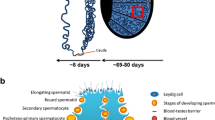Abstract
Exposure of male mice to trichloroethylene vapours during 24 h at levels of 50,202 and 450 ppm did not reveal mutagenic effects in the dominant lethal assay. The following parameters were registered and evaluated: Fertilization rate, post-implantation loss, preemplantation loss and dominant lethal mutations.
Zusammenfassung
Die Belastung von männlichen Mäusen mit TrichloräthylenDämpfen in Konzentrationen von 50, 202 und 450 ppm über 24 h zeigte keine mutagenen Wirkungen im Dominant-Letal-Test. Folgende Parameter wurden registriert und bewertet: Befruchtungsrate, postimplantativer Verlust, präimplantativer Verlust und dominante letale Mutationen.
Similar content being viewed by others
References
Axelson O, Anderson K, Hogstedt C, Holmberg B, Molina G, de Verdier A (1978) A cohort study on trichloroethylene exposure and cancer mortality. J Occup Med 20:194–196
Bartsch H, Malaveille C, Barbin A, Planche G (1979) Mutagenic and alkylating metabolites of halo-ethylenes, chlorobutadienes and dichlorobutenes produced by rodent or human liver tissues. Arch. Toxicol. 41:249–277
Bonse G, Henschler D (1976) Chemical reactivity, biotransformation, and toxicity of polychlorinated aliphatic compounds. CRC Rev Toxicology 4:395–409
Callen DV, Wolf CR, Philpot RM (1980) Cytochrome P-450 mediated genetic activity and cytotoxicity of seven halogenated aliphatic hydrocarbons in Saccharomyces cerevisiae. Mutat Res 77:55–63
Ehling UH, Machemer L, Buselmaier W, Dycka J, Frohberg H, Kratochvilova J, Lang R, Lorke D, Müller D, Pen J, Röhrborn G, Roll R, Schulze-Schencking M, Wiemann H (1978) Standard protocol for the dominant lethal test on male mice. Set up by the work group ‘Dominant lethal mutations of the ad hoc committee chemogenetics’. Arch Toxicol 39:173–185
Glatt HR, Oesch F, Frigerio A, Garattini S (1975) Epoxides metabolically produced from some known carcinogens and from some clinically used drugs. I. Differences in mutagenicity. Int J Cancer 16:787–797
Greim H, Bonse G, Radwan Z, Reichert D, Henschler D (1975) Mutagenicity in vitro and potential carcinogenicity of chlorinated ethylenes as a function of metablic oxirane formation. Biochem Pharmacol 24:2013–2017
Henschler D, Romen W, Elsässer HM, Reichert D, Eder E, Radwan Z (1980) Carcinogenicity study of trichloroethylene by long term inhalation in three animal species. Arch Toxicol 43:237–248
Henschler D, Eder E, Neudecker T, Metzler M (1977) Carcinogenicity of trichloroethylene: fact or artefact? Arch Toxicol 37:233–236
Konietzko H, Haberlandt W, Heilbronner H, Reill G, Weichardt H (1978) Cytogenetische Untersuchungen an Trichloräthylen-Arbeitern. Arch Toxicol 40:201–206
Laib RJ, Stöckle G, Bolt HM, Kunz W (1979) Vinyl chloride and trichloroethylene: Comparison of alkylating effects of metabolites and induction of preneoplastic enzyme deficiencies in rat liver. J Cancer Res Clin Oncol 94:139–147
NCI(National Cancer Institute) (1976) Carcinogenesis Bioassay of Trichloroethylene. Techn Rep Ser No 2, NCI-CG-TR-2, US DHEW, Washington
NIOSH(National Institute for Occupational Safety and Health) (1976) Criteria for a recommended standard-occupational exposure to trichloroethylene. HSM-73-11025, US DHEW, Washington, p 15
Oesch F (1976) Metabolic transformation of clinically used drugs to epoxides: New perspectives in drug interactions. Biochem Pharmacol 25:1935–1937
Roll R, Slacik-Erben R, Scheffler Cl (in press 1980) Results of the dominant lethal assay on male mice with polycyclic aromatic hydrocarbons
Shahin MM, von Borstel RC (1977) Mutagenic and lethal effects of α-benzenehexachloride, dibutylphthalate and trichloroethylene in Saccharomyces cerevisia. Mutat Res 48:173–180
Simmon VF, Kauhanen K, Tardiff RG (1977) Mutagenic activity of chemicals identified in drinking water. In: Scott D, Bridges BA, Sobels, FH (eds), Progress in Genetic Toxicology, Elsevier/North-Holland
Tabarelli-Poplawski S, Uehleke H (1977) Irreversible binding of 3-14C-antipyrine to hepatic protein in vivo and in metabolizing liver microsomes. Arch Pharmacol 297:105–110
Uehleke H, Poplawski-Tabarelli S (1977) Irreversible binding of 14C-labelled trichloroethylene to mice liver constituents in vivo and in vitro. Arch Toxicol 37:289–294
Uehleke H, Tabarelli-Poplawski S, Bonse G, Henschler D (1977) Spectral evidence for 2,2,3-trichlorooxirane formation during microsomal trichloroethylene oxidation. Arch Toxicol 37:95–105
Uehleke H, Brinkschulte-Freitas M (1978) Kinetics and metabolism of 2,2-diethylallylacetamide in dog and man. Arch Pharmacol 302:11–18
Van Duuren BL, Banerjee S (1976) Covalent interaction of metabolites of the carcinogen trichloroethylene in rat hepatic microsomes. Cancer Res 36:2419–2422
Author information
Authors and Affiliations
Rights and permissions
About this article
Cite this article
Slacik-Erben, R., Roll, R., Franke, G. et al. Trichloroethylene vapours do not produce dominant lethal mutations in male mice. Arch. Toxicol. 45, 37–44 (1980). https://doi.org/10.1007/BF00303293
Received:
Issue Date:
DOI: https://doi.org/10.1007/BF00303293




